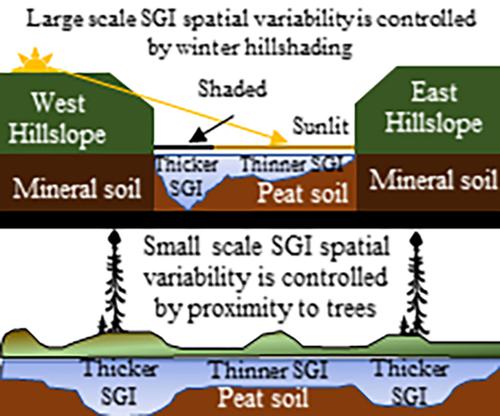当前位置:
X-MOL 学术
›
Hydrol. Process.
›
论文详情
Our official English website, www.x-mol.net, welcomes your
feedback! (Note: you will need to create a separate account there.)
Quantifying the spatial variability of melting seasonal ground ice and its influence on potential evapotranspiration spatial variability in a boreal peatland
Hydrological Processes ( IF 2.8 ) Pub Date : 2020-06-25 , DOI: 10.1002/hyp.13840 Brandon Van Huizen 1 , Richard M. Petrone 1
Hydrological Processes ( IF 2.8 ) Pub Date : 2020-06-25 , DOI: 10.1002/hyp.13840 Brandon Van Huizen 1 , Richard M. Petrone 1
Affiliation

|
Melting seasonal ground ice (SGI) in western Boreal Plains (WBP) peatlands can reduce the available energy at the surface by reducing potential evapotranspiration (PET). PET often exceeds annual precipitation in the WBP. Including this effect in hydrological models may be important in assessing water deficits. However, SGI melt and the timing of ice‐free conditions vary spatially, which suggests PET spatial variability could be influenced by SGI. Understanding this potential linkage can help improve site scale PET in peatland hydrological models. The objectives of this paper were (a) to quantify the effect of ice thickness and melt rate on peatland PET; (b) quantify the spatial variability of SGI thickness and melt rate across spatial scales; and (c) assess how/if spatial variability in SGI thickness/melt rate affects site scale PET. Results from the sensitivity analysis indicated that SGI thickness had a bigger impact on reducing PET compared with the melt rate. Two SGI thickness values were used that were observed on site: 0.32 m, which was measured in a more treed area, and 0.18 m, which was in a more open area. The 0.32 m had an average PET reduction of 14 mm (±0.7), over the month of May, compared with 9 mm (±1 mm) when there was 0.18 m of SGI, which are 13.7 and 8.8% reductions, respectively. SGI thickness and melt rate, both exhibited large‐ and small‐scale spatial variability. At the large scale, spatial patterns in SGI thickness appeared to be influenced by extensive shading from the adjacent hillslopes. Small scale, SGI thickness may be a function of tree proximity and the snowpack. Finally, net radiation, rather than SGI, appeared to be the main driver behind PET spatial variability. This work enhances our conceptual understanding of the role of SGI in WBP peatlands. Future work can use the findings to better inform peatland hydrological models, allowing for better representation of peatlands in regional‐scale models.
中文翻译:

量化季节性泥冰融化的空间变异性及其对北方泥炭地潜在蒸散量空间变异性的影响
在西部的北方平原(WBP)泥炭地融化季节性地面冰(SGI)可以通过减少潜在的蒸散量(PET)来减少表层的可用能量。PET经常超过WBP中的年降水量。在水文模型中包括这种影响可能对评估缺水量很重要。但是,SGI融化和无冰条件的发生时间在空间上有所不同,这表明PET空间变异性可能受SGI影响。了解这种潜在的联系可以帮助改善泥炭地水文模型中的站点规模PET。本文的目的是(a)量化冰厚度和融化速率对泥炭地PET的影响;(b)在整个空间尺度上量化SGI厚度和熔化速率的空间变异性;(c)评估SGI厚度/熔解速率的空间变化如何/是否影响站点规模的PET。敏感性分析的结果表明,与熔融速率相比,SGI厚度对降低PET的影响更大。使用了两个在现场观察到的SGI厚度值:0.32 m(在更绿树的区域中测量)和0.18 m(在更开阔的区域中)。在5月份,0.32 m的PET平均减少14 mm(±0.7),而当SGI为0.18 m时,PET平均减少9 mm(±1 mm),分别减少13.7和8.8%。SGI厚度和熔解速率均表现出大尺度和小尺度的空间变异性。在大范围内,SGI厚度的空间格局似乎受到邻近山坡阴影的影响。小规模的SGI厚度可能是树木接近程度和积雪的函数。最后,是净辐射而不是SGI,似乎是PET空间变异性的主要驱动力。这项工作增强了我们对SGI在WBP泥炭地中的作用的概念理解。未来的工作可以利用这些发现更好地为泥炭地水文模型提供信息,从而在区域尺度模型中更好地表示泥炭地。
更新日期:2020-06-25
中文翻译:

量化季节性泥冰融化的空间变异性及其对北方泥炭地潜在蒸散量空间变异性的影响
在西部的北方平原(WBP)泥炭地融化季节性地面冰(SGI)可以通过减少潜在的蒸散量(PET)来减少表层的可用能量。PET经常超过WBP中的年降水量。在水文模型中包括这种影响可能对评估缺水量很重要。但是,SGI融化和无冰条件的发生时间在空间上有所不同,这表明PET空间变异性可能受SGI影响。了解这种潜在的联系可以帮助改善泥炭地水文模型中的站点规模PET。本文的目的是(a)量化冰厚度和融化速率对泥炭地PET的影响;(b)在整个空间尺度上量化SGI厚度和熔化速率的空间变异性;(c)评估SGI厚度/熔解速率的空间变化如何/是否影响站点规模的PET。敏感性分析的结果表明,与熔融速率相比,SGI厚度对降低PET的影响更大。使用了两个在现场观察到的SGI厚度值:0.32 m(在更绿树的区域中测量)和0.18 m(在更开阔的区域中)。在5月份,0.32 m的PET平均减少14 mm(±0.7),而当SGI为0.18 m时,PET平均减少9 mm(±1 mm),分别减少13.7和8.8%。SGI厚度和熔解速率均表现出大尺度和小尺度的空间变异性。在大范围内,SGI厚度的空间格局似乎受到邻近山坡阴影的影响。小规模的SGI厚度可能是树木接近程度和积雪的函数。最后,是净辐射而不是SGI,似乎是PET空间变异性的主要驱动力。这项工作增强了我们对SGI在WBP泥炭地中的作用的概念理解。未来的工作可以利用这些发现更好地为泥炭地水文模型提供信息,从而在区域尺度模型中更好地表示泥炭地。











































 京公网安备 11010802027423号
京公网安备 11010802027423号